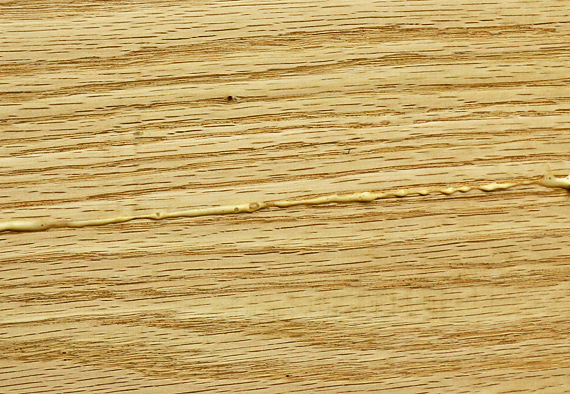
The real problem with glue squeeze-out is not taking the matter seriously. If you pretend that when it appears, squeeze-out is really a surprise, you are likely to waste time and get poor results. It is more efficient to anticipate and manage it as a legitimate part of your joinery and glue up plan.
In many cases, such as edge-to-edge joinery (above), squeeze-out is functional. Consider that too little glue and just the right amount of glue look about the same when the joint is assembled. A modest squeeze-out ensures that you have not used too little glue. (It’s that one-sided tolerance thing again.)
Edge joints are easy to manage. I wait until the squeeze-out is rubbery, and then gently scrape away most of it. The remainder is removed when surfacing the panel after the glue is cured. I never use a wet cloth to wipe away excess glue in careful work. That spreads the glue and helps it soak into the wood. Unless the glue is very diluted by this process, it can interfere with finishing.
It is important to think through how and where the glue will be pushed as the joint goes together, and then how you will deal with the excess. Each situation is different. Where there is good access on the outside surfaces of a joint, such as carcase dovetails, I let the glue go where it wants, knowing that I will later scrape away the glue and create a wood surface that is unadulterated by the glue.
The inside surfaces are a different matter. Removing glue from the inside corners could be a pain, or a big pain if there is excessive glue that has soaked down into the wood fibers, and maybe even a royal pain if the wood is cherry, for example, and will be getting an oil finish.
My favorite solution is to simply line the inside surfaces adjacent to the joint with 3M #2080EL blue tape. This takes little time. I set the tape very close to the joint line but make sure to avoid putting the tape where it would prevent the joint from fully closing – it only takes a bit to mess up the glue up.
What about the outside of a dovetailed drawer joint? If you plan to plane or scrape away a substantial amount of excess glue, especially if it has seeped into the end grain or the side grain of a coarsely textured wood, that may change the fit of the drawer, depending on your drawer fitting technique. Consider that clamps may thwart access to the squeeze-out when it is in its rubbery stage and easy to remove.
I do not have a universal approach to this, but it usually is fine to gauge the glue to minimize squeeze-out, plane down the sides, and just barely touch the end-grain of the pins. I find Lee Valley 2002GF glue to be a big help here because it does not seep into the grain if it is not pressed upon. And, all of this depends on the wood species and finish.
For mortise-and-tenon work, I try to avoid external squeeze-out all together. I am generous with the glue in the mortise. I do think the best practice is to put glue on the tenons, just enough to ensure the glue wets the surface. I use a very thin coat, but because this can quickly skin over, I work fast and it is the last step before bringing the joints together. I usually leave about 1/8 inch extra at the bottom of the mortise for the excess glue inside the joint.
In frame and panel work, I pay attention to the corners to anticipate where the glue might squeeze out. This is part of planning the joinery. I don’t want to make a mess there and inadvertently seize the panel at the corners in its groove. Sometimes I wax the corners of the panel if there is little room for error.
Another approach to squeeze-out in general is described in detail by Michael Fortune in Fine Woodworking, issue #232, April 2013. He uses a non-silicone wax applied sparingly around the joint where squeeze-out is anticipated. Glue will not stick to it and so is easily removed. Later, the wax is removed with alcohol. This works for sure but it does take work. I think it is best for awkward areas and especially with shellac or oil finishes for which a little remaining wax will not interfere with adhesion.
The point is to think it through – squeeze-out is part of woodworking.

